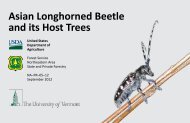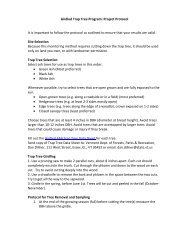Alternatives to Commonly Planted Invasive Plants - Vermont Invasives
Alternatives to Commonly Planted Invasive Plants - Vermont Invasives
Alternatives to Commonly Planted Invasive Plants - Vermont Invasives
You also want an ePaper? Increase the reach of your titles
YUMPU automatically turns print PDFs into web optimized ePapers that Google loves.
<strong>Alternatives</strong> <strong>to</strong> <strong>Commonly</strong> <strong>Planted</strong> <strong>Invasive</strong> <strong>Plants</strong><br />
<strong>Invasive</strong> Species<br />
Japanese Barberry<br />
Berberis thunbergii<br />
Japanese Barberry is an ornamental<br />
shrub that that is attractive because of<br />
its colors and dark red berries. It also<br />
comes in various heights and can be<br />
used is as be shaped in<strong>to</strong> hedges.<br />
Bush Honeysuckles Lonicera morrowil,<br />
Lonicera maackii, Lonicera x bella<br />
Lonicera tatarica<br />
Bush Honeysuckles have been planted<br />
mostly for their ornamental value,<br />
including the fragrant flowers and red<br />
berries.<br />
Burning Bush<br />
Euonymus alatus<br />
Burning Bush is used as an ornamental<br />
shrub, and is valued for its neat habit<br />
and spectacular red <strong>to</strong> pink fall color. It<br />
is shade <strong>to</strong>lerant.<br />
Norway Maple<br />
Acer platanoides<br />
Norway Maple is an ornamental tree.<br />
Some cultivars have a maroon leaf color<br />
which it keeps throughout the growing<br />
season.<br />
Buckthorn<br />
Rhamnus cathartica<br />
Buckthorn is a shrub/small tree that is<br />
valued for its hardiness and its ability <strong>to</strong><br />
grow in a variety of soil and light<br />
conditions. It has been used in many<br />
areas <strong>to</strong> create hedges.<br />
Bishop’s Goutweed<br />
Aegopodium podagraria<br />
Bishop’s Goutweed is used as an<br />
ornamental ground cover, especially on<br />
steep slopes. If flourishes in moist,<br />
shaded areas.<br />
Non-<strong>Invasive</strong> <strong>Alternatives</strong><br />
* native <strong>to</strong> <strong>Vermont</strong><br />
• Black Chokeberry * • Northern Bayberry<br />
• Common Winterberry *<br />
• Highbush Blueberry *<br />
• Inkberry *<br />
• Meadowsweet *<br />
• Beach plum<br />
• Black Chokeberry *<br />
• Black Elderberry *<br />
• But<strong>to</strong>nbush *<br />
• Arrowwood *<br />
• Black Chokeberry *<br />
• But<strong>to</strong>n bush *<br />
• Fragrant Sumac *<br />
• Highbush Blueberry *<br />
• Blackgum *<br />
• Red maple *<br />
• Sugar maple *<br />
• American Bladdernut *<br />
• Beach plum *<br />
• Black Chokeberry *<br />
• But<strong>to</strong>nbush *<br />
• Canadian Anemone *<br />
• Canadian Wild Ginger *<br />
• Wild Blue Phlox or Sweet<br />
William<br />
• Wild Sarsaparilla *<br />
• Sliky Dogwood *<br />
• Smokebush<br />
• Sweetfern *<br />
• Sweet Pepperbush<br />
• Common Winterberry *<br />
• Silky dogwood *<br />
• Spicebush *<br />
• Trumpet honeysuckle<br />
• Nannyberry *<br />
• Northern Bayberry<br />
• Shining Sumac<br />
• Smokebush<br />
• Smooth Sumac *<br />
• Serviceberry *<br />
• Silky Dogwood *<br />
• Speckled Alder *<br />
• Witchhazel *<br />
For more information on invasives and good alternatives go <strong>to</strong><br />
www.nature.org.vermont/weeds; www.vtinvasives.org; www.beplantwise.org or call 802-229-4425.
Characteristics of Select <strong>Alternatives</strong><br />
Beach plum Prunus maritima<br />
Multi-branched shrub, 1 – 8 ft tall. Egg shaped, finely<br />
<strong>to</strong>othed leaves. White fruit in umbels along the stem.<br />
Fruit purple. Salt Tolerant.<br />
Fruit eaten by birds and wildlife.<br />
Light: Full Sun<br />
Moisture: Dry<br />
Soil:<br />
Sandy<br />
Black Chokeberry, Aronia melanocarpa<br />
A small, mound-shaped shrub. Glossy, dark green<br />
foliage turns crimson-red in fall. White flowers with<br />
pink anthers. Persistent, blackish-purple berries.<br />
Provides nectar <strong>to</strong> insects, fruit provides food for birds<br />
and mammals.<br />
Light: Part Shade, Full Sun<br />
Moisture: Moist , Dry<br />
Soil: Sandy, acid<br />
But<strong>to</strong>nbush Cephalanthus occidentalis<br />
Shrub, 3-10 ft, with flowers in round, ball-like heads.<br />
White , tubular flowers. Egg shaped leaves opposite<br />
or whorled.<br />
Provides food for variety of wildlife.<br />
Light: Shade, Part Shade, Full Sun<br />
Moisture: Moist, Wet<br />
Soil: All kinds<br />
Fragrant Sumac, Rhus aromatica<br />
A sprawling, small <strong>to</strong> medium-size shrub (6-12 ft. tall)<br />
with aromatic foliage. Has glossy, somewhat bluegreen<br />
leaves which turn orange, red, purple and<br />
yellow in the fall. Yellowish catkin-like flowers precede<br />
dark-red berries which persist in<strong>to</strong> March. The<br />
berries provide winter food for small animals and<br />
birds. Attracts birds & butterflies<br />
Is highly deer resistant<br />
Light: Sun , Part Shade , Shade<br />
Moisture: Moist, Dry<br />
Soil: Dry, rocky soils. Sandy, Sandy Loam, Medium<br />
Loam, Clay Loam Clay,<br />
Black Elderberry, Sambucus canadensis<br />
A deciduous shrub with branches <strong>to</strong> 12 ft. Leaves up<br />
<strong>to</strong> 12 inches long. Flowers white in conspicuous<br />
clusters appearing from May <strong>to</strong> July. Fruit berrylike,<br />
dark purple when ripe, edible when ripe. Berries<br />
relished by many bird species and mammals. Deer eat<br />
twigs and leaves. Attracts birds and is a nectar<br />
source.<br />
Light: Part Shade<br />
Moisture: Wet<br />
Soil: Tolerates a wide variety of wet <strong>to</strong> dry soils but<br />
prefers rich, moist, slightly acid soil.<br />
Blackgum, Nyssa sylvatica<br />
A handsome ornamental and shade tree which has<br />
glossy, dark-green summer foliage changing <strong>to</strong><br />
fluorescent yellow, orange, scarlet and purple in fall.<br />
Grows <strong>to</strong> 30-60 ft. or taller. Berries are small and<br />
blue. It is also a honey plant. The juicy fruit is<br />
consumed by many birds and mammals. Used by<br />
substrate-insectivorous birds, Fruit-birds, Fruitmammals,<br />
Nectar-bees. Attracts birds.<br />
Light: Sun , Part Shade , Shade<br />
Moisture: Moist<br />
Soil: Various acid soils. Acid-based, Gravelly, Sandy,<br />
Sandy Loam, Medium Loam, Clay Loam, Clay.<br />
Common Winterberry, Ilex verticillata<br />
A very “showy” shrub, especially in fall & early winter<br />
with its bright red berries. Provides cover, nesting<br />
site, nectar for insects and fruit for birds. Attracts<br />
birds & butterflies.<br />
NOTE: Need both male and female plants <strong>to</strong> have<br />
berries.<br />
Light: Sun , Part Shade , Shade<br />
Moisture: Wet , Moist , Dry<br />
Soil: Moist, acidic soils. Sandy, Sandy Loam Medium<br />
Loam Clay Loam, Clay<br />
Highbush Blueberry, Vaccinium corymbosum<br />
A deciduous shrub with reddish-green spring leaves<br />
which turn blue-green in summer and red, yellow,<br />
orange and purple in fall. White or pink, bell-shaped<br />
flowers in drooping clusters. Blue fruit. Berries are<br />
relished by most birds and mammals. Browsers eat<br />
foliage. Attracts 30 species of birds.<br />
Light: Sun, Part Shade, Shade<br />
Moisture: Wet, Moist, Dry<br />
Soil: Wet <strong>to</strong> dry, acid, rocky soils <strong>to</strong> organic peats.
Northern Bayberry, Morella pensylvanica<br />
A spreading shrub, 3-12 ft. tall. Glossy, fragrant graygreen,<br />
turn tan-colored and persist in<strong>to</strong> winter. Green<br />
catkins appear before leaves. Clusters of small, round,<br />
hard, white berries remain on the female plant all<br />
winter. Berries eaten by winter birds. Attracts birds &<br />
butterflies<br />
Light: Part Shade<br />
Moisture: Moist<br />
Soil: Clay, Loam, Sand<br />
Serviceberry Amelanchier<br />
Shrub or small tree with early white spring flowers in<br />
loose racemes at the end of branches. In the rose<br />
family.<br />
Light: Sun, Part Shade<br />
Moisture: Dry, Moist<br />
Soil: Loamy, Sandy<br />
Smooth Sumac, Rhus glabra<br />
An ornamental, 10-20 ft. shrub with short, crooked,<br />
picturesque branches. Deciduous leaves become<br />
extremely colorful in early fall. On female plants,<br />
yellow-green flowers are followed by bright-red, hairy<br />
berries which persist throughout winter. Berries<br />
consumed by birds of many kinds and small<br />
mammals, mainly in winter. Deer browse the twigs<br />
and fruit throughout the year. Attracts birds &<br />
butterflies.<br />
Light: Sun , Part Shade , Shade<br />
Moisture: Dry<br />
Soil: Most dry soils. Sandy, Sandy Loam Medium<br />
Loam, Clay Loam, Clay, Caliche type<br />
Sugar maple, Acer saccharum<br />
Large (60-75 ft.) shade tree with rounded, dense<br />
crown and striking, brilliant red, yellow and orange<br />
fall foliage. Its straight, central trunk; wide-spreading<br />
branches; and pointed crown are all attractive<br />
landscape characteristics. Attracts Birds<br />
It is susceptible <strong>to</strong> salt. (Dirt)<br />
Light: Sun , Part Shade , Shade<br />
Moisture: Moist , Dry<br />
Soil: Rich, moist, well-drained soils.<br />
Red maple, Acer rubrum<br />
A shade tree, displaying red in different seasons. This<br />
is a preferred species for browsing deer and moose.<br />
Attracts Birds and is larval host and/or nectar source<br />
for Rosy Maple Moth<br />
Light: Sun , Part Shade<br />
Moisture: Moist<br />
Soil: Clay, Loamy, Sandy. Slightly acidic soils.<br />
Shining Sumac, Rhus copallinum<br />
A large, deciduous ornamental shrub or small tree,<br />
20-35 ft. tall. Glossy, dark-green leaves turn reddishpurple<br />
in the fall. Yellowish-green flowers are<br />
succeeded by drooping fruit clusters which turn dull<br />
red and persist through winter. Often forms thickets.<br />
Winter food for many upland game birds, songbirds,<br />
and large and small mammals. Wildlife eat the fruit,<br />
and deer also browse the twigs.<br />
Light: Sun<br />
Moisture: Dry<br />
Soil: Rocky, poor soils.<br />
Spicebush, Lindera benzoin<br />
A single- or few-stemmed, deciduous shrub, 6-12 ft.<br />
tall. Dense clusters of tiny, pale yellow flowers which<br />
are followed by glossy red fruit. Both fruit and foliage<br />
are aromatic. Leaves turn a colorful golden-yellow in<br />
fall. Attracts Birds & Butterflies. Larval host for<br />
Eastern Tiger Swallowtail, Spicebush Swallowtail<br />
Light: Sun , Part Shade , Shade<br />
Moisture: Wet , Moist , Dry<br />
Soil: Moist, sandy, well-drained soils. Caliche type,<br />
Limes<strong>to</strong>ne-based, Sandy Loam, Medium Loam<br />
Sweet Pepperbush Clethra alnifolia<br />
1 – 4 foot shrub with sweet-scented white flowers in<br />
long racemes. Egg shaped leaves, sharply <strong>to</strong>othed<br />
above the middle. Attracts pollina<strong>to</strong>rs.<br />
Light: Part Shade, Full Shade<br />
Moisture: Moist, Wet<br />
Soil: Clay, Loamy, Sandy
Trumpet honeysuckle, Lonicera sempervirens<br />
High-climbing, twining vine, 3-20 ft. long, with<br />
smooth, glossy, semi-evergreen leaves and 2-4<br />
flowered clusters of red, tubular blooms followed by<br />
bright-red berries. Not <strong>to</strong>o aggressive. Good climber<br />
or ground cover. Flowers attract hummingbirds, bees,<br />
and butterflies. Fruits attract quail, Purple Finch,<br />
Goldfinch, Hermit Thrush, American Robin. Nectar<br />
source. Larval host for Spring Azure, Snowberry<br />
Clearwing Moth.<br />
Light: Sun, Part Shade<br />
Moisture: Dry, Moist<br />
Soil: Various soils, but rich preferred.<br />
Witchhazel Hamamelis virginiana<br />
Shrub, 5-15 ft., with yellow flowers that bloom in late<br />
fall. Leaves are long (2-5”) and egg shaped with wavy<br />
edges.<br />
Provides food for birds and small mammals.<br />
Light: Part Shade, Shade<br />
Moisture: Dry, Moist<br />
Soil: Clay, Loamy, Sandy














